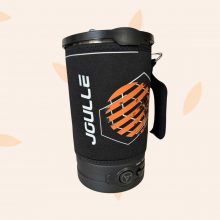Looking for a unique way to relax and rejuvenate near Las Vegas? This city doesn’t just offer grand casinos and dazzling nightlife – it’s also home to some amazing hot springs.
From Gold Strike Hot Springs’ stunning canyons to the desert oasis of Blue Point Springs, we’ve researched and compiled the best local hot springs that you should definitely consider visiting.
Ready to take a therapeutic dip? Let’s dive in!
Key Takeaways
- Las Vegas has many great hot springs. Favorites include Gold Strike Hot Spring and Arizona Hot Springs.
- Soaking in a hot spring can make you feel relaxed and lower your stress.
- Many hot springs have spots for having a picnic or camping nearby.
- Stay safe when visiting a hot spring. Be careful on wet ground, don’t touch plants or animals, and clean up after yourself.
What Are Hot Springs and Their Benefits?
Hot springs are unique pools of water that are naturally heated by the Earth. People have been using hot springs for hundreds of years to improve their physical well-being.
Hot springs offer health benefits due to their mineral content. They can alleviate skin irritations, help with arthritis and menopausal symptoms, and treat digestive disorders. Other benefits include respiratory relief, stress reduction, and improved circulation.
Top Hot Springs Near Las Vegas
Immerse yourself in the healing waters of Gold Strike Hot Spring, revel in the rustic charm of Arizona Hot Spring or take a dip at Rogers Spring.
Test your endurance with a soak at Blue Point Spring’s heated pool, or explore off-the-beaten-path spots like Alkali Hot Springs and Warm Springs.
For a serene experience, visit Fish Lake Valley Hot Well or Trego hot spring; each offer unique features perfect for relaxation after exploring Las Vegas’ bustling city life.
Public Hot Springs

Gold Strike Hot Springs (36.5 miles)
Gold Strike Hot Springs is located just a stone’s throw away from the buzz of Las Vegas. The area is near Boulder City and Hoover Dam, on the Arizona/Nevada border. A challenging 4-mile hike along the Colorado River leads to hot spring pools with water seeping from rocky canyon walls.
- Location: Gold Strike Hot Springs is accessible via a 6-mile round trip hike.
- Hiking: The hike in to Gold Strike Hot Springs is an exciting experience, and even involves the use of ropes to assist you in navigating large boulders. The overall hike is moderately difficult and typically takes approximately 3-4 hours to finish.
- Hot Springs: The hot springs are the main attraction, with water temperatures ranging from 100°F to 109°F. The hot springs can be found in a series of natural rock soaking pools that stretch for about two miles along the canyon.
- Geothermal activity: Gold Strike Canyon is an area with a lot of geothermal activity. It has hot pools, grottos, and even hot waterfalls. The hot springs come from where the Palm Tree fault and the Salt Cedar fault zone meet.
- Safety: The hike to Gold Strike Hot Springs can be risky. It is important for visitors to take necessary precautions such as staying well-hydrated, applying sunscreen, and avoiding the hike during extreme heat. It is also important for visitors to be cautious of flash floods and other natural dangers.
- Fees: $25 fee per car.
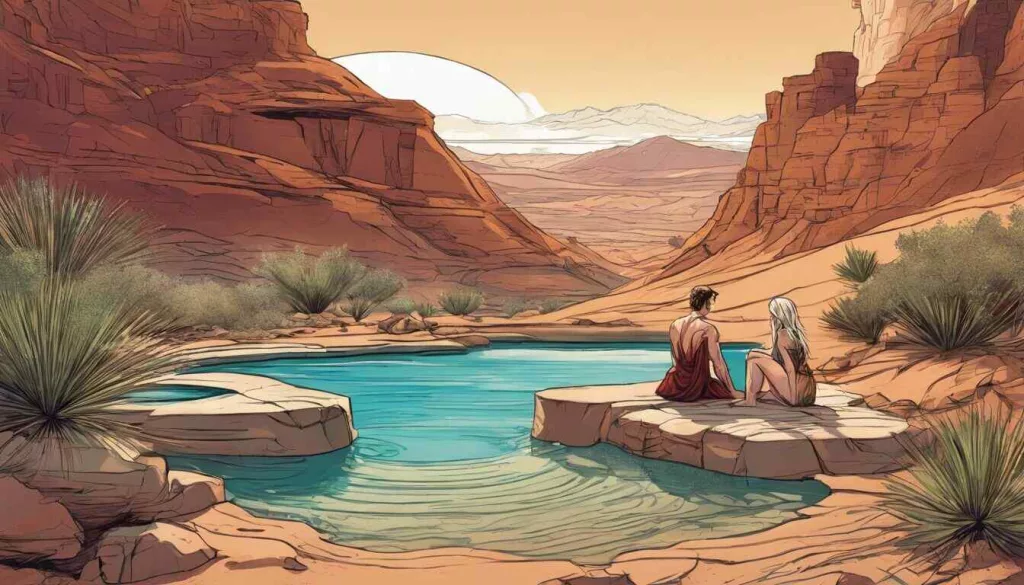
Arizona Hot Spring (40 miles)
Lake Mead Visitor Center
10 Lakeshore Rd
Boulder City, NV 89005
Arizona Hot Spring, also known as the Ringbolt Hot Springs, is near Lake Mohave on the Colorado River. You can reach the springs by hiking about 2.5-miles through the Lake Mead National Recreation Area, or by boat along the river.
- Location: Arizona Hot Spring is situated between narrow rock walls of a slot canyon and consists of multiple pools located approximately 1,000 feet from the river.
- Accessibility: The hike to Arizona Hot Spring is an intermediate level hike that involves navigating boulders, gravel, and using ropes for ascending and descending. The trail is in a beautiful slot canyon that connects to the river near Ringbolt Rapid.
- Hot Springs: The hot springs range in temperature from 101°F to 106°F and are scattered throughout the area. The springs may change depending on the season and flash floods.
- Safety: In the summer, it’s not recommended to hike due to extreme heat. Visitors should take precautions like bringing extra water, wearing proper hiking shoes, and taking a cold plunge in the Colorado River.
- Fees: A Standard Entrance Pass is required for all visitors at a cost of $15.00–$25.00.
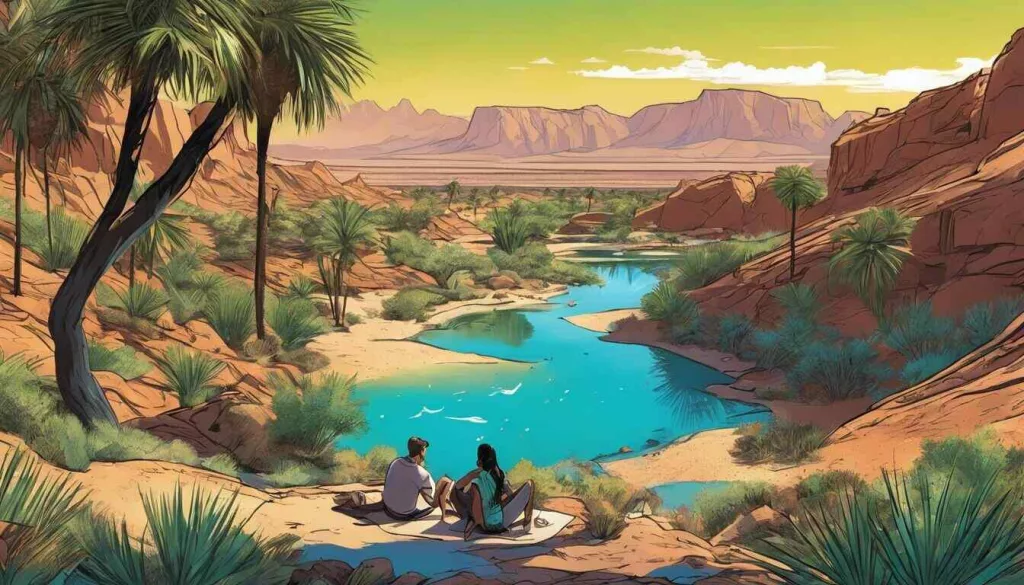
Rogers Spring (55 miles)
Lake Mead Visitor Center
10 Lakeshore Rd
Boulder City, NV 89005
Rogers Spring is a close one-hour trip from Las Vegas, next to Lake Mead in Southern Nevada. The water stays around 85 degrees here. This spring is part of the “North Shore Complex.” It’s easy to get to and a good place for a quick soak.
- Location: Rogers Spring is a popular desert oasis on the north shore of Lake Mead, Nevada, easily accessible and attracting many visitors.
- Accessibility: The spring is conveniently located a short one-hour drive from Las Vegas. Additionally, there are several nearby hiking trails that provide stunning views of the surrounding landscape.
- Hot Springs: The spring temperature varies with the season, reaching a comfortable 85 degrees Fahrenheit.
- Fees: A standard pass is $25 /per vehicle.
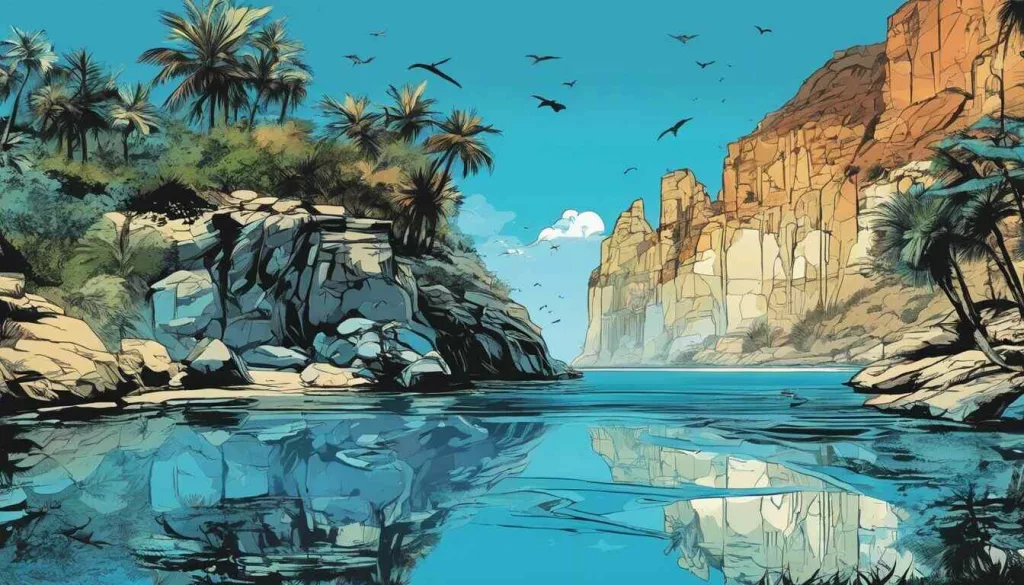
Blue Point Spring (56 miles)
Blue Point Spring sits in Lake Mead, Nevada in the Lake Mead National Recreation Area. Palm trees and other desert plants decorate the landscape around Blue Point Spring, with rocky cliffs in close proximity to the spring. This is not a deep spring and can be difficult to find, depending on the time of year and level of rainfall.
With warm temperatures making it perfect for a dip any time of year, Blue Point Spring invites you to come relax under the Nevada sky surrounded by nature’s own spa design.
- Location: Blue Point Spring is located in an overgrown area within the Lake Mead area. The hot springs are shallow and difficult to find
- Hot Springs: Blue Point Spring is a location where water flows and creates a small area of greenery with a few palm trees. It is a constant source of water and serves as the habitat for desert fan palms (Washingtonia filifera).
- Recreational Use: Blue Point Spring is popular for bird watching and nature enthusiasts due to the water, greenery, and unique aquatic springsnail, Pyrgulopsis coloradensis, found exclusively there.
Twelve-Mile (Bishop Creek) Hot Springs (97 miles)
Twelve-Mile Hot Springs is located in a beautiful canyon of the Gold Butte National Monument, in the northeastern area of Nevada. It’s a secluded, primitive hot spring experience that feels more like having your own private pool party – without the noise, The Virgin River is nearby for those that want to take a cold plunge, giving visitors a nice mix of hot springs and chilly river.
- Location: Located 12 miles north of Wells, Nevada. A high clearance 4WD vehicle is recommended for direct access. During the rainy season, visitors may need to park and hike about 2 miles.
- Hot Springs: Accessible year-round, the hot springs have a water temperature over 100°F and a soaking pool separated from Bishop Creek by a concrete wall.
- Activities: Dispersed camping is available, and visitors should practice Leave No Trace principles.
- Fees: The hot springs are free to access.
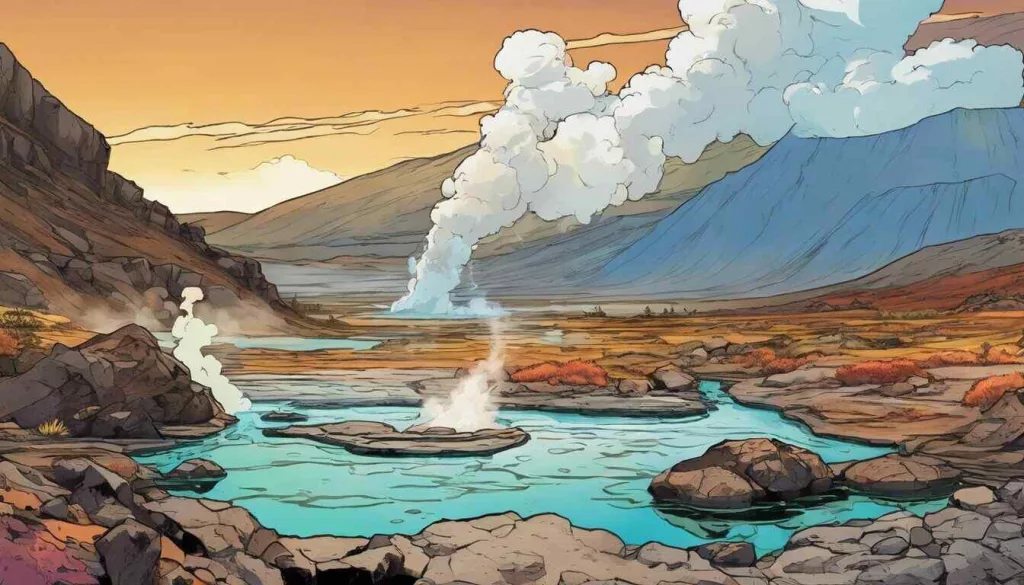
Alkali Hot Springs (195 miles)
Silver Peak Rd
Dyer, NV 89010
Alkali Hot Springs, located in the ghost town of Alkali, in the central desert of Nevada. The hot spring is easily accessible from Las Vegas and has two naturally formed rock tubs with water temperature ranging from around 105 degrees Fahrenheit. Note that although it’s not explicitly stated, this may be a clothing optional hot springs.
- NOTE: These cement-lined soaking tubs may be closed to the public.
- Location: Alkali Hot Springs is located in the central desert of Nevada, near Alkali Lake, a seasonal saline lake.
- Description: The springs are rock-walled tubs that are not regularly maintained and contain a lot of algae. Lucky visitors may even see wild Mustang horses running in the distance.
- Historical Significance: Alkali Hot Springs has a rich history, with a mining town that thrived during the gold rush and a former nearby hot spring resort from the 1930s.
- Fees: Free
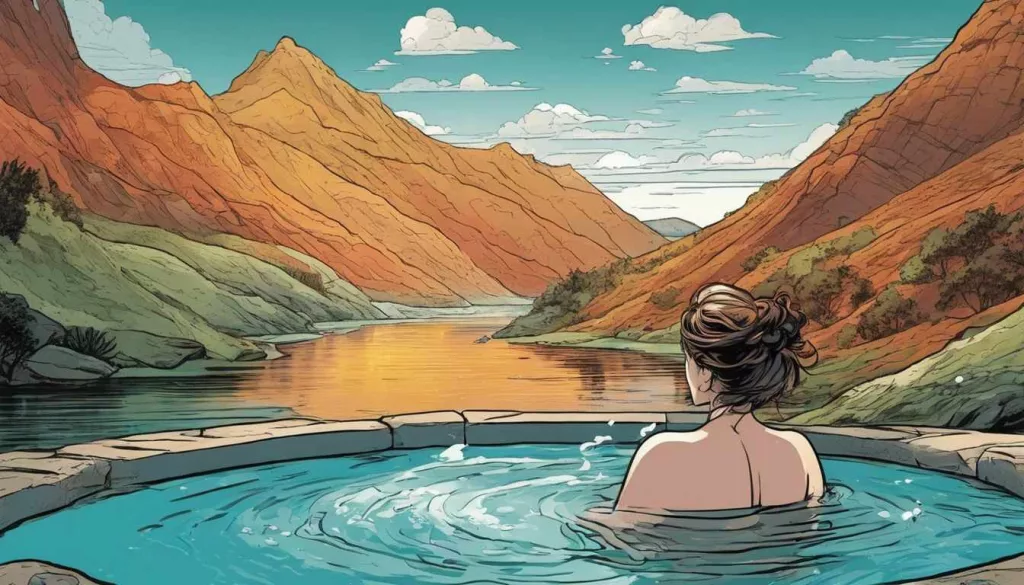
Warm Spring (206 miles)
4240 Warm Springs Rd.
Moapa, NV 89025
Warm Spring is an oasis conveniently located near Las Vegas. It’s easy to reach by car and is surrounded by wildlife and lush greenery.
- Location: The Warm Springs Natural Area is a 1,250-acre oasis in Moapa, Nevada, featuring more than two dozen bubbling springs, rushing streams, and lush wetlands.
- Hot Springs: The hot springs are situated in a serene location along Nevada’s western edge near the California state line, offering a natural oasis with a large parking area, primitive campsites, and a vault toilet.
- Fees: Free to the public.
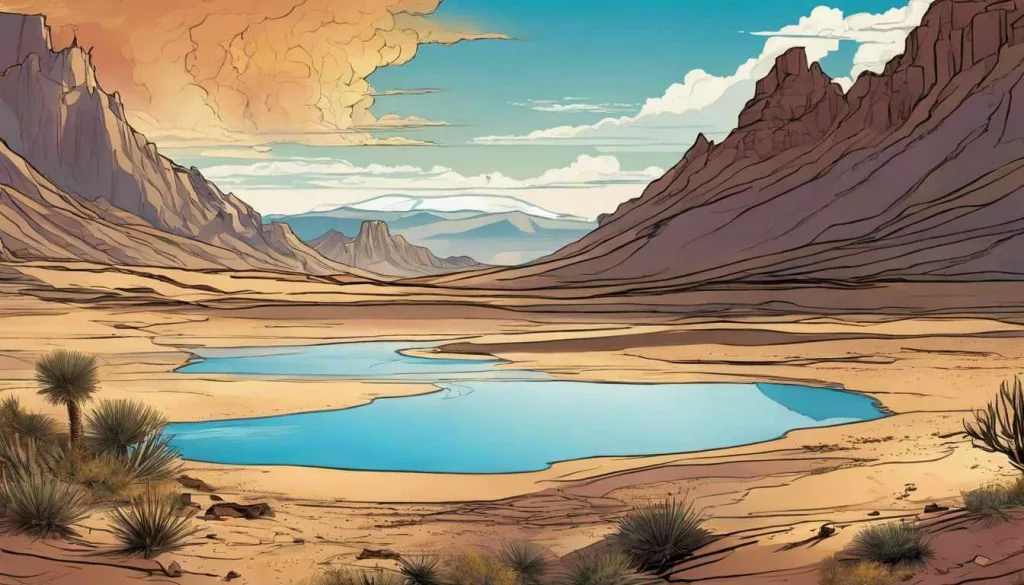
Fish Lake Valley Hot Well (250 miles)
Valley Center Road
Dyer, Nevada 89010
Fish Lake Hot Well, also known as Fish Lake Hot Spring, is a geothermal hot spring located near the town of Dyer, Nevada.
- Location: The hot spring is located near the Nevada-California border, about an hour west of Tonopah. The area is surrounded by mountains, near the Boundary Peak Wilderness area.
- Hot Springs: The pool overflows into a man-made swimming hole stocked with large goldfish. There are also two more ponds that the warm water flows into, each with a different temperature, ranging from 85°F to 105°F.
- Accessibility: The area is accessible to everyone, with plenty of parking space, simple campsites, and a toilet facility.
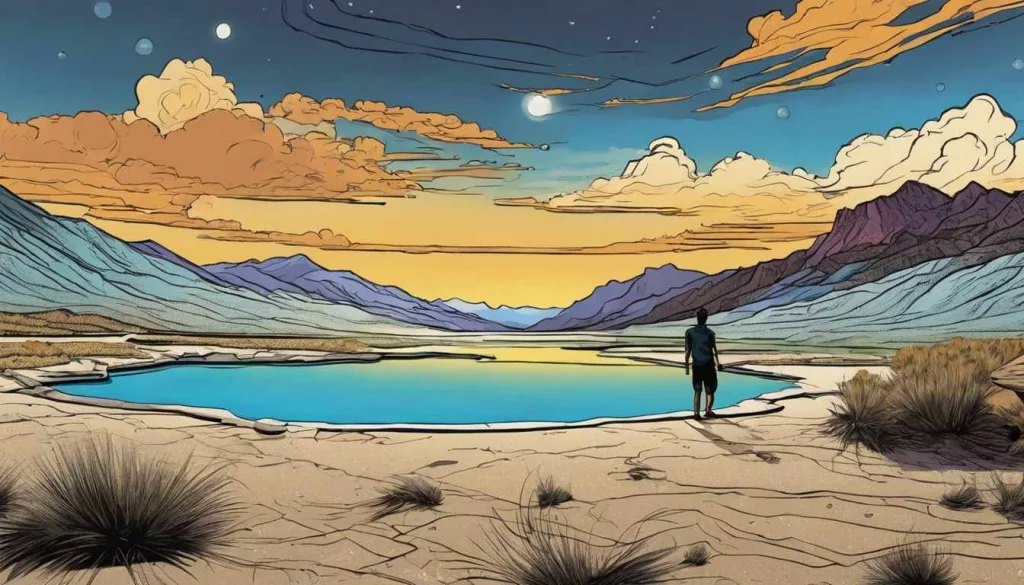
Spencer Hot Springs (350 miles)
Spencer Hot Springs is a secluded destination for nature enthusiasts and adventure seekers. Located on untouched public land, this hidden gem provides visitors with an unforgettable off-road hot springs experience.
- NOTE: Spencer Hot Springs is clothing optional.
- Location: Spencer Hot Springs is in northern Nevada, off Highway route 50 and about 19 miles from Austin, NV. Access is via a gravel road off SR376 and managed by the Nevada BLM. Toiyabe National Forest is visible from this location.
- Hot Springs: Spencer Hot Springs has various geothermal sources, including a metal tub hot spring and a larger pool with a mud bottom. The water temperature and pressure are constant, and visitors can adjust the temperature by controlling the water source in and out of the tubs.
- Safety: The water at Spencer Hot Springs is extremely hot. Follow safety guidelines, respect the natural surroundings, practice good hygiene, and adhere to hot spring etiquette.
- Activities: Campers should be at least 100 yards away from water sources and follow fire restrictions and hot spring etiquette. Camping near water sources is not allowed for safety and preservation.
- Fees: Spencer Hot Springs is free for the public. Primitive camping is available on a first-come, first-served basis.

Ruby Valley Hot Springs (400 miles)
South of Ruby Wash Road
Nevada 89833
- Location: The hot springs are in the Ruby Valley Refuge, which is about an hour away from Elko, Nevada. The springs can be reached by taking several roads: NV-227 E, NV-228 S, Harrison Pass Rd, Old Harrison Pass Rd, NF-113, NF-357, and Ruby Valley Rd, followed by an unpaved road for about 3.2 miles.
- Hot Springs: Ruby Valley Hot Springs have multiple pools of varying temperatures. The largest pool is about 30 feet deep and has an average temperature of 100 degrees Fahrenheit. There are also smaller pools nearby, each with different temperatures and accessibility.
- Safety: Be cautious when navigating the marshy area and accessing the pools.
- Fees: Free
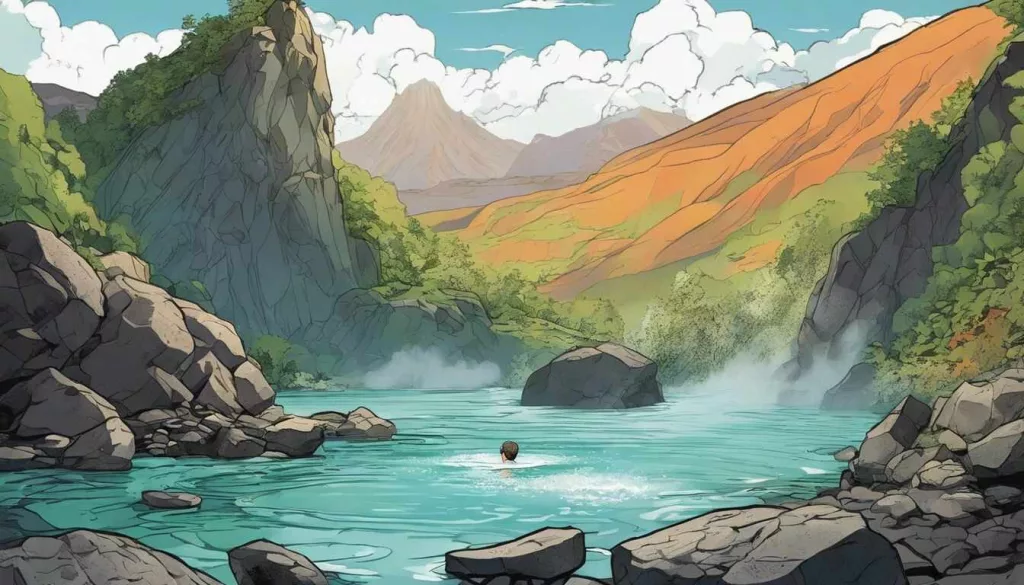
Trego Hot Spring (450 miles)
Trego Hot Springs, Jungo Rd
Trego, Nevada 89445
Trego Hot Springs is located in the Black Rock Desert-High Rock Canyon Emigrant Trails National Conservation Area. It’s also surrounded by ancient volcanic rocks and rests on land managed by the Bureau of Land Management.
- SAFETY NOTE: In 2020, the BLM reported high levels of E. Coli, Fecal Coliforms and Vibrio Cholera in Trego Springs.
- Location: The springs are next to railroad tracks and are open to the public on BLM land, free of charge. There is also a 400-foot trench for a warm-water pond experience.
- Historical Significance: The name “Trego” originated in the 1910s, after the construction of the railroad. The springs have a historical connection to the Western Pacific Railroad and have had different names, such as Hot Springs, Kyles Hot Springs, Butte Spring, and Butte Hot Spring.
- Hot Springs: Temperatures can vary from warm to very hot, so visitors should be careful when entering the springs. The springs are known for its warm-water pond with natural mud bath.
How to Stay Safe While Visiting Hot Springs
Hot Springs Health Precautions
While hot springs can be enjoyable and have potential health benefits, there are risks associated with hot springs and bacteria that can thrive in these environments.
- Bacterial Infections:
- Legionella: Hot springs can provide a suitable environment for the growth of Legionella bacteria, which can cause Legionnaires’ disease, a severe form of pneumonia. Inhalation of steam or mist containing the bacteria can lead to infection.
- Pseudomonas aeruginosa: This bacterium is known to thrive in warm water and can cause skin rashes and ear infections.
- Protozoan Infections:
- Naegleria fowleri: This amoeba is found in warm freshwater and soil. While it is rare, it can cause a severe brain infection (amoebic meningoencephalitis) if contaminated water enters the nose. Hot springs could be a potential habitat for this amoeba.
- Skin Infections:
- Dermatophilosis: Hot springs might harbor bacteria that can cause skin infections, especially if the water is not adequately treated or if individuals with open wounds immerse themselves.
- Water Quality and Contamination:
- Fecal Coliform Bacteria: Hot springs can be contaminated by human or animal fecal matter, introducing harmful bacteria. Inadequate sanitation and water treatment can contribute to this problem.
- Respiratory Issues:
- Steam Inhalation Risks: Inhaling steam from hot springs can lead to respiratory issues, particularly if there are high levels of harmful bacteria or other contaminants in the steam.
To reduce the risks associated with bacteria in hot springs, consider the following precautions:
- Check Local Health Advisories: Be aware of any health advisories or warnings related to specific hot springs.
- Avoid Submerging Open Wounds: If you have open wounds or cuts, it’s advisable to avoid immersing them in hot spring water to prevent infections.
- Shower Before and After: Showering before and after using hot springs can help reduce the risk of bacterial infections.
- Choose Well-Maintained Springs: Opt for hot springs that are well-maintained, regularly tested for water quality, and have good sanitation practices in place.
Hot Springs Safety Precautions
- Check for Local Guidelines:
- Be aware of and adhere to any rules or guidelines posted at the hot spring. Different hot springs may have specific regulations regarding swimming attire, time limits, and other considerations.
- Test the Water Temperature:
- Before fully immersing yourself, test the water temperature with your hand or foot. Hot springs can vary widely in temperature, and some may be too hot for comfortable soaking.
- Don’t put your head under the water in the hot spring.
- Use clips for your nose in the water.
- Stay Hydrated:
- Soaking in hot water can lead to dehydration. Drink plenty of water before, during, and after your visit to the hot spring.
- Avoid Hot Springs with Excessive Heat:
- Some hot springs can become extremely hot, potentially causing burns or discomfort. Avoid springs that are too hot for your comfort, and be cautious of scalding water.
- Be Cautious with Certain Health Conditions:
- If you have certain health conditions, such as heart problems, high blood pressure, or skin conditions, consult with a healthcare professional before visiting hot springs. In some cases, soaking in hot water may not be advisable.
- Never touch plants or animals you find near hot springs – they may harm you!
- Shower Before Entering:
- Many hot springs encourage visitors to shower before entering the pool to remove lotions, oils, and other substances that can affect water quality.
- Respect the Environment:
- Follow Leave No Trace principles and respect the natural environment around the hot spring. Avoid disturbing plants and wildlife, and properly dispose of any waste.
- Keep the noise low and be kind to others at the hot spring.
- Leave no mess behind. Make sure the place looks better than it did before you came.
- Always look after yourself and people around you. Be careful about slipping on wet grounds or stepping on sharp rocks under water.
- Supervise Children:
- If you’re visiting with children, supervise them closely. Hot springs can vary in depth, and some areas may not be suitable for young swimmers.
- Know Your Limits:
- Don’t overstay your welcome in the hot spring. Prolonged exposure to hot water can lead to fatigue and dehydration. Take breaks, cool off, and listen to your body.
- Be Mindful of Altitude:
- If the hot spring is at a high altitude, be aware that the effects of altitude, such as dehydration and fatigue, may be more pronounced. Take it easy and acclimate gradually.
- Use Caution in Remote Areas:
- If the hot spring is in a remote location, be prepared with essentials like water, snacks, and appropriate clothing. Inform someone about your plans and expected return time.
What to Expect When Visiting a Hot Spring
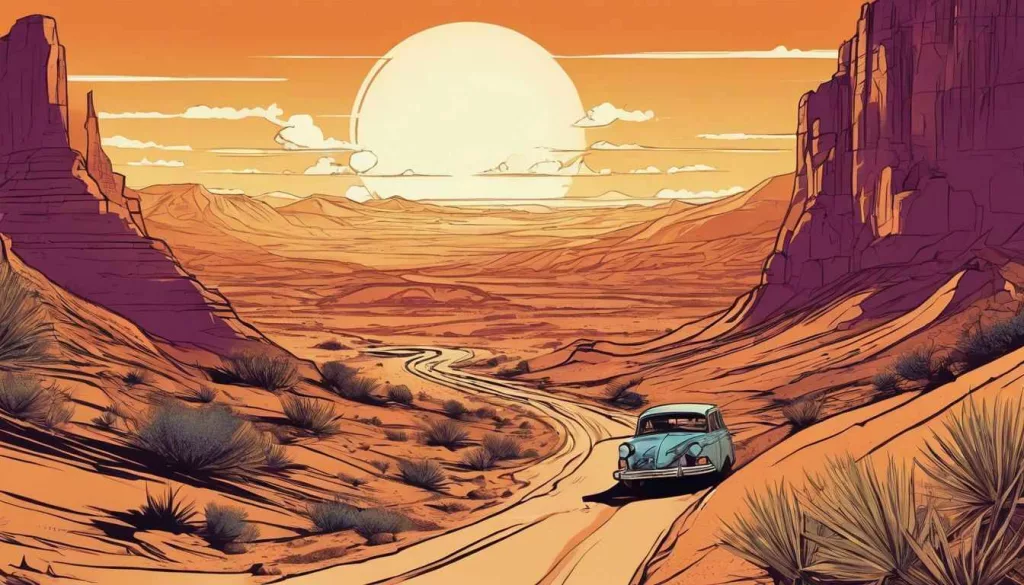
Visiting a hot spring can be a unique and enjoyable experience. It’s important to respect the dress code and etiquette, which involves being considerate of others’ space while soaking in the spring.
While specific expectations may vary depending on the location and facilities, here are some general things you can expect when visiting a hot spring:
Water Temperature
Hot spring water is heated by our Earth’s center heat and can come in various temperatures. The water can be warm in some places, hot in others. And in places with volcanoes, the water can touch extremely hot rocks. It’s essential to be cautious and test the water temperature before fully immersing yourself.
- Cool Springs (Below 90°F or 32°C): Some hot springs may have temperatures that are warmer than the surrounding environment but still relatively cool compared to other hot springs. These springs might be suitable for relaxation rather than intense soaking.
- Warm Springs (90°F to 98°F or 32°C to 37°C): Springs in this temperature range provide a comfortably warm experience. They are often suitable for relaxation and may be popular for recreational use.
- Hot Springs (98°F to 110°F or 37°C to 43°C): Hot springs in this temperature range offer a warmer soaking experience. Many hot springs fall within this temperature range, providing a pleasant and relaxing environment.
- Very Hot Springs (Above 110°F or 43°C): Some hot springs can reach temperatures that are too hot for prolonged soaking. While they may have therapeutic benefits, visitors need to exercise caution and be mindful of their time in the water.
Mineral Content
Hot springs are known for their mineral content, which can vary. The minerals present in the water are believed by some to have therapeutic properties and may contribute to the overall experience.
Here are some common minerals that are often found in hot springs:
- Sulfur: Sulfur is a common mineral in hot springs and is known for its distinctive smell. Sulfur compounds are believed by some to have skin-healing properties.
- Silica: Silica is a mineral that is often found in hot springs and is known for its skin-conditioning properties. It can leave the skin feeling soft and smooth.
- Calcium: Hot springs may contain calcium, which is beneficial for bone health. Calcium-rich hot springs are believed by some to have a relaxing effect on muscles and joints.
- Magnesium: Magnesium is another mineral commonly found in hot springs. It is thought to have a calming effect on the nervous system and may contribute to muscle relaxation.
- Sodium and Potassium: These electrolytes are often present in hot springs and can contribute to the overall mineral content. They play essential roles in various bodily functions.
- Carbonate: Carbonate minerals may be present in hot springs, contributing to the water’s alkalinity.
- Iron: Some hot springs contain iron, which can give the water a reddish or brownish color. Iron is an essential mineral for the human body.
- Lithium: Lithium is occasionally found in hot springs and is believed by some to have mood-stabilizing effects.
Natural Setting
Hot springs are often located in scenic natural settings, such as mountains, valleys, or near bodies of water. The surroundings can contribute to a tranquil and relaxing atmosphere.
Indoor or Outdoor Pools
Hot springs can have both indoor and outdoor pools. Outdoor pools allow you to enjoy the natural surroundings, while indoor pools provide a more controlled environment.
Rules and Etiquette
Hot springs often have specific rules and etiquette that visitors are expected to follow. These may include guidelines on showering before entering the pool, keeping noise levels down, and respecting the natural environment.
Clothing / Dress Code
Depending on the hot spring’s rules, clothing options may vary. Each hot spring has its own rules on what to wear. Some are clothing optional nudist, while others require swimwear.
Be sure to check and respect the rules of the specific hot spring you’re visiting. Also, keep in mind that some hot springs may allow nudity and not be appropriate for children under the age of 18.
Time Limits
Some hot springs may have recommended time limits for soaking to prevent dehydration and other health concerns. Be sure to pay attention to any posted guidelines.
Reservations (if applicable)
If the hot spring is part of a resort or facility that offers other amenities, it may be advisable to make reservations in advance, especially during peak times.
How to Get to These Hot Springs
Whether you’re hailing a ride share or decoding public transport schedules, each journey promises its own adventure – just don’t expect any yellow brick roads leading straight to geothermal bliss.
Rental car
Renting a car is like having a magic carpet in the deserts around Las Vegas. It takes you from one steamy hot spring to another, no sweat.
Having a car at your command means freedom. Say goodbye to sticking to someone else’s timetable; hello to rolling down windows and chasing where the dirt roads end. Let’s say you’re soaking up good vibes at Ruby Valley Hot Springs and get an itch for adventure; with your trusty vehicle, it’s easy peasy to cruise over to Lake Tahoe for even more stunning views.
Ride sharing
You might think getting to a hot spring near Las Vegas would be as simple as hopping in a car and going. But let’s face it, not everyone rolls into town with their own transportation. Good news is, there’s an easy fix: ride sharing! You can call up an Uber or Lyft to get a ride directly to where you want to go.
Public transportation
Getting to these hot springs without a car is like trying to find a snowflake in the desert — rare and tricky. Buses and trains don’t really make stops at these steaming pools of bliss.
Public transport outside of Las Vegas is infrequent and unreliable; it’s simply not the bet you want to make.
Activities to Do at Hot Springs
Relax and rejuvenate by soaking in the warm waters of a hot spring. Go on scenic hikes, exploring the surrounding terrain that is often rich in flora and fauna. Set up camp for an overnight stay to enjoy the serene nature setting under a sky full of stars.
Soaking
Soaking is a fun thing to do at hot springs. You sit in warm water that comes from the ground. This can help you feel good and relax your body. The Arizona Hot Spring near Las Vegas is a great place for this.
But, take note! It closes from May 15 to September 30 because of very hot weather. No matter what time of year it is, soaking in a hot spring pool makes for an amazing day out near Las Vegas.
Hiking
Hiking is a big part of the fun in visiting hot springs near Las Vegas. Hikes like the Gold Strike Hot Springs Trail and the trail to Arizona Hot Springs through White Rock Canyon are full of joy.
You see wildlife, jump off cliffs, or relax with third-class scrambling activities. The hike might be tough but it brings you stunning wide views. It also leads you to narrow canyons where hidden springs wait for soaking and relaxing moments.
Camping
Note that you can’t camp directly near hot springs, you’ll need to find a designated site to setup your tent or RV.
There are many cool places to put up your tent. The Lake Mead National Recreation Area is one of them. It has many camping spots for you to choose from.
For those who want to stay close to a hot spring, Tecopa Hot Springs Resort and Campground is a good choice. This place lets guests use private hot spring tubs. Montezuma Hot Springs also has camping options for those who love natural thermal waters.
Tips for Planning Your Visit
Start by researching the best times to visit hot springs near Las Vegas. Check if reservations are required and any possible admission fees. Consider accessibility too, bearing in mind that some locations might require a hike or special transport to reach.
Best time to go
You should visit the hot springs near Las Vegas in winter because of the very high heat in summer months. Winter or early spring visits will give you a good soak without risk of overheating.
Here are some things to considers when planning your visit:
- Weather:
- Nevada can experience extreme temperatures, especially in the summer. Hot springs may be more enjoyable during the cooler months (fall, winter, and early spring) when daytime temperatures are milder. Be cautious during the summer, as some areas can get very hot.
- Crowds:
- Weekdays and non-holiday periods generally see fewer visitors compared to weekends and holidays. If you prefer a more peaceful experience, consider visiting hot springs during off-peak times.
- Seasonal Changes:
- Keep in mind that hot springs in higher elevations may be affected by seasonal changes, including snow in the winter. Some hot springs may be inaccessible or have limited facilities during certain times of the year.
- Wildflower Blooms:
- Depending on the location, the spring months might bring wildflower blooms, adding to the beauty of the natural surroundings. Check with local sources to learn about the flora in the area.
- Fall Foliage:
- If the hot springs are situated in areas with deciduous trees, the fall months could offer stunning displays of autumn foliage. This can enhance the overall scenic experience.
- Avoiding Extreme Temperatures:
- If you’re planning to soak in hot springs with high temperatures, such as those near geothermal features, it may be more comfortable to visit during cooler parts of the day, such as mornings or evenings.
- Checking for Closures:
- Some hot springs may be closed during certain times for maintenance, environmental protection, or safety reasons. Check with local authorities or management for any closures or restrictions.
- Moonlit Soaks:
- For a unique experience, consider visiting hot springs during a full moon. The natural surroundings illuminated by moonlight can create a magical atmosphere.
Accessibility
The accessibility of hot springs in Nevada can vary widely depending on their location, whether they are situated in remote wilderness areas or near more developed regions. Here are some general considerations for accessing hot springs in Nevada:
- Remote Locations:
- Some hot springs in Nevada are located in remote or wilderness areas. Accessing these hot springs may require hiking, often on uneven or challenging terrain. Be prepared for outdoor conditions, and ensure you have appropriate gear, maps, and knowledge of the area.
- Road Conditions:
- Access to hot springs may involve driving on unpaved roads, especially if the springs are in more secluded areas. Check current road conditions, and be aware that certain roads may be impassable during certain seasons or weather conditions.
- Permits and Regulations:
- Some hot springs may be located on public lands, and specific permits or passes may be required. Additionally, there might be regulations in place to protect the environment, and it’s important to follow them to minimize impact.
- Facilities and Developed Areas:
- Certain hot springs in Nevada may be part of resorts, parks, or other developed areas. These locations might have more accessible facilities, parking, and amenities.
- Local Knowledge:
- Check with local sources, such as visitor centers, tourism offices, or online forums, for the most up-to-date information on accessing hot springs. Locals or experienced visitors may provide valuable insights into the current conditions and any challenges you might encounter.
- Seasonal Considerations:
- Weather conditions can vary significantly in Nevada. Be mindful of seasonal changes, especially if you’re planning to visit hot springs at higher elevations where snow and cold temperatures may be a factor.
- Respect Private Property:
- Some hot springs may be on private land. Always respect private property rights and obtain permission from landowners if necessary.
- Group Size:
- If you’re traveling in a group, consider the capacity of the hot springs and whether they can accommodate the number of people in your party. Some hot springs may have limited space.
How to Book Your Hot Spring Experience
Ready to experience Nevada’s steamy oasis? Learn how you can plan your trip with a blend of do-it-yourself planning or the assistance of expert tour companies. Dive in for more details!
DIY trips
You can have fun trips to hot springs all by yourself. All you need to do is plan and go! Ringbolt Hot Springs and Tule Springs are great for this type of trip.
Both places have pretty sights that will make your day special. Another place for a DIY trip is Death Valley Hot Springs. It has wonderful views that take your breath away. The 12-Mile Hot Springs is also perfect for a DIY visit.
You can soak in the beautiful, natural hot spring and feel at peace with nature around you.
Things to Bring and Consider Before Your Visit
To optimize your hot springs visit, don’t forget essentials like a towel, water shoes and sun protection. Also, consider your own physical abilities and restrictions before embarking on the trip.
Towel
You will need a towel for your hot spring trip. It is used to dry off after a soak. Some places give towels for free. Others let you buy one there. Some hot springs make you wear a towel in the bath, while others say no to them.
But, most times you can bring a small towel into the bath area at hot springs even if nakedness is needed. Hot springs in Glenwood even give out towels for people who come by.
Water shoes
Water shoes are your best friend on a hot spring trip near Las Vegas. They guard your feet from sharp things or uneven ground in the pool. Water shoes also give you sure steps on wet, muddy paths.
The bottom of hot springs can be rocky and tricky to walk on. With water shoes, you won’t slip or hurt your feet. Make sure to wear them for a safe and fun visit to the hot springs!
Sun protection
Always apply sunscreen when visiting hot springs near Las Vegas. It helps to fight off the strong desert sun. Use a good quality lotion with at least SPF 30. It will guard your skin from harmful UV rays and lower your risk of skin cancer.
Don’t skip this step even if it’s cloudy! Water can make the sun’s effect stronger, so be careful in the spring’s pool too. Protecting our skin is very important for health, and it also keeps us looking young by preventing wrinkles.
Physical abilities and restrictions
Going to hot springs can need a lot of strength. Some places may ask you to walk a long way. You might have to climb hills or go through rough paths. Make sure you are fit and strong enough for this.
If walking is hard, find out if the spring has good ways to get there for all people. Be safe at all times in your visit. Keep an eye out for signs that tell you dangers or rules of the place.
Conclusion
Finding a hot spring near Las Vegas is easy. These places are great for fun and rest. Go to Gold Strike or Arizona Hot Springs for a good time. Make sure you pick the right one for your wants!
Las Vegas Hot Springs FAQs
1. How many natural hot springs are in Nevada?
Nevada boasts an impressive number of over 300 natural hot springs spread across its diverse and scenic landscapes. This abundance of natural hot springs positions the state as the top destination for natural hot springs.
2. What happened to Warm Springs Nevada?
Warm Springs, established in 1866, once served as a stage stop but declined in population as roads and automobiles improved. The town was previously a popular summer destination and historical stage stop for travelers, but has since transformed into an abandoned ghost town with deteriorating buildings and a private hot springs.
3. Can I swim at these hot springs?
Yes! Many hot springs in Nevada are deep enough to swim in. Take care though: always check safety rules before going swimming holes.
4. Are there any facilities near these hot springs?
Many natural springs around Las Vegas like Bishop Hot or those along Colorado river come with useful items like fire pits for free camping and platforms at the edge for better access to spring water.
Tell us about your Nevada hot springs experience!
If yes, please let us know so that we can update our list. Send us a message and make note of the address and reasons why the location should be included.





